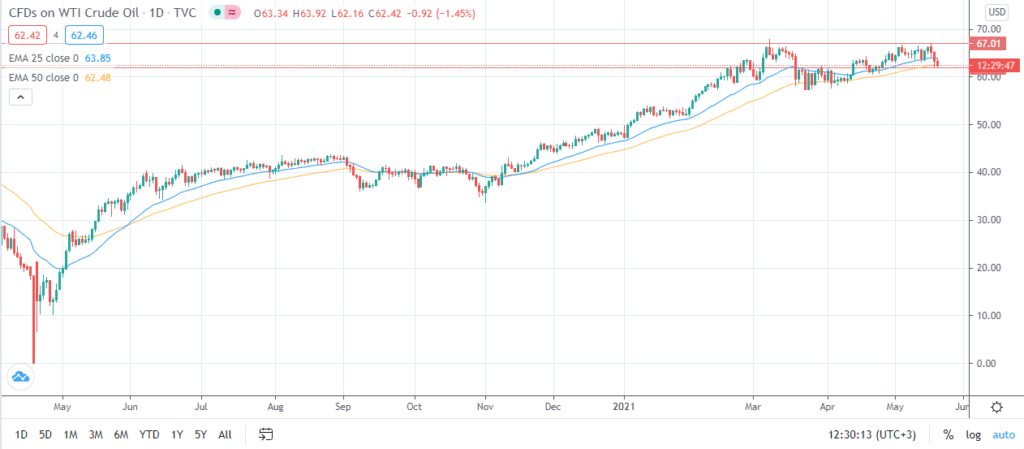- As the European countries reopen for air travelers, the number of air bookings is more than double.
- Oil stockpiles have increased according to the recent data from EIA.
- The Net Zero report by IEA supported the oil prices.
Air travel recovery
The ongoing recovery of air travel, both in the US and other parts of the globe, has heightened optimism on the recovery of global oil demand. On Sunday, data from the Transportation Security Administration (TSA) showed that 1,850,531 people passed through their screening checkpoints. The figure beat the previous record hit last week on 13th May at 1,743,515 passengers. Furthermore, it was the first time for the agency to record over 1.8 million individuals flying on a single day since the beginning of the coronavirus pandemic. While the numbers have since dropped to Tuesday’s 1,408,017 individuals, the recent figures are a sign of the recovery of air travel, which is a bullish catalyst for the crude oil price. Besides, large passenger numbers are usually a typical scenario on Sundays.
At the same time, United Airlines has indicated that it will add over 400 daily flights to its July schedule. As various European countries reopen, summer travel bookings to multiple destinations within the continent have risen by 214%, which is more than triple the levels in 2020. In the United States, the airline expects its July schedule to be 80% of the same period in 2019. The monthly figure is the highest since the onset of the coronavirus pandemic.
US crude oil inventories
Crude oil price is also reacting to the weekly US oil inventories. On Tuesday, the American Petroleum Institute (API) indicated that the amount of crude oil in storage rose by 0.620 million barrels in the past week. While the figure is lower than the forecasted build of 1.680 million barrels, it is significantly higher than the prior reading of -2.533 million barrels.
According to API, oil stockpiles have increased by over 50 million barrels since the beginning of 2020. Despite the lower-than-expected inventories in the past week, recent data from EIA (Energy Information Administration) has highlighted a rise in US oil production. As for the week ending on 7th May, production rose by 100,000 bpd to an average of 11 million bpd.
Notably, EIA’s data on oil inventories confirmed the trend depicted by API. Analysts expected crude oil stockpiles to have risen by 1.623 million barrels compared to the prior reading of -0.427 million barrels. However, the reading came in better than expected by highlighting a lesser build of 1.321 million barrels. While it still represents a rise in inventories, the lower-than-expected figure is a bullish catalyst for the crude oil price.
As for gasoline inventories, the recorded decline by 1.963 million barrels is considerably higher than the forecasted drop of 0.886 million barrels. In the previous release, gasoline stockpiles had risen by 0.378 million barrels. The better-than-expected readings are a sign of rising demand as summer travels improve.
IEA’s Net Zero report
The Net Zero report released by the International Energy Agency (IEA) has further supported crude oil prices. Granted, the report is neither a prediction nor a recommendation for governments in their efforts to hit the net zero CO2 emissions target by 2050. However, the agency is usually influential in the formulation of energy policies. In the recent report, IEA indicated the need to halt all the new gas and oil exploration projects. Execution of the report would impact oil demand and supply dynamics.
Crude oil technical outlook
The crude oil price has been trading on a horizontal channel between $62 and $67 for close to a month now. At the time of writing, WTI futures were down by 1.5% at $62.39. On a daily chart, it is trading along the 50-day EMA and slightly below the 25-day EMA. The price is likely to continue finding support along $62. On the upper end, it may rise to $64 amid the ongoing recovery in oil demand. However, in the ensuing sessions, it may revive its uptrend by rising to $67.




